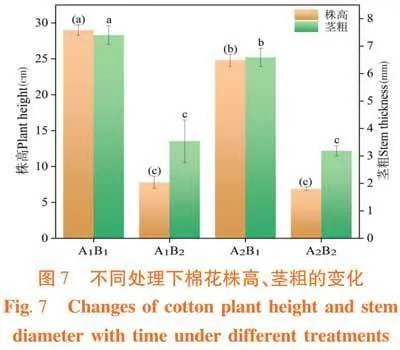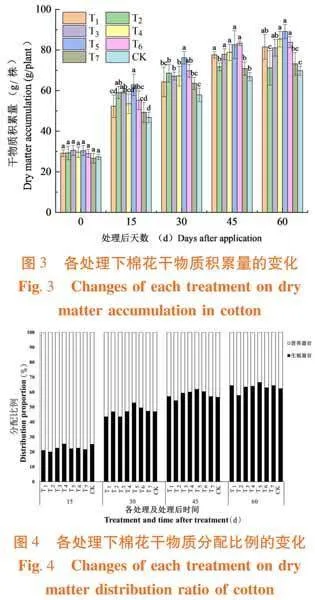中图分类号:S562 文献标志码:A 文章编号:1001-4330(2025)02-0294-08
摘要:【目的】探究不同灌溉量处理对棉花的发育、产量和水分利用效率的作用机理。【方法】在新疆博乐市设置大田试验,以正常灌溉量为对照  ),设置(正常灌溉的 8 0 %
),设置(正常灌溉的 8 0 %  、正常灌溉的
、正常灌溉的 、正常灌溉的 4 0 %
、正常灌溉的 4 0 %  )不用水分梯度,测定棉花不同生育期株高、主茎节数、果枝数、结铃和脱落特征,采收期测定棉花产量构成。【结果】(1)相比正常灌溉处理,亏缺灌溉使棉花的蕾期、花期、盛铃期、吐絮期分别提前了
)不用水分梯度,测定棉花不同生育期株高、主茎节数、果枝数、结铃和脱落特征,采收期测定棉花产量构成。【结果】(1)相比正常灌溉处理,亏缺灌溉使棉花的蕾期、花期、盛铃期、吐絮期分别提前了  (2)蕾期之后,棉花株高、主茎节间长度、果枝数和单株蕾铃数均表现出随着灌溉量减少而降低的趋势;主要分布在冠层中下部的结铃和坐果数均随灌水量减少而降低。(3)棉花整株生物量表现出灌溉量减少而降低趋势。(4)籽棉产量表现出灌溉量减少而降低趋势,正常灌溉处理籽棉产量达
(2)蕾期之后,棉花株高、主茎节间长度、果枝数和单株蕾铃数均表现出随着灌溉量减少而降低的趋势;主要分布在冠层中下部的结铃和坐果数均随灌水量减少而降低。(3)棉花整株生物量表现出灌溉量减少而降低趋势。(4)籽棉产量表现出灌溉量减少而降低趋势,正常灌溉处理籽棉产量达  ,分别比亏缺灌溉处理高出 7 . 0 % ~ 3 2 . 4 % ,主要由单株铃数降低所致;随着灌溉量减少,灌溉水分利用效率逐渐提高,重度缺水处理最高,达
,分别比亏缺灌溉处理高出 7 . 0 % ~ 3 2 . 4 % ,主要由单株铃数降低所致;随着灌溉量减少,灌溉水分利用效率逐渐提高,重度缺水处理最高,达  。【结论】适度的亏缺灌溉有助于提前棉花开花和结铃时间,缩短棉花生育期。
。【结论】适度的亏缺灌溉有助于提前棉花开花和结铃时间,缩短棉花生育期。
0 引言
【研究意义】新疆是我国最大的优质棉生产基地[1]。2022年新疆棉花总产量高达  ,占据全国总产量的
,占据全国总产量的  。然而,尽管新疆拥有丰富的光热资源,但其干旱半干旱的地理特征导致水资源严重匮乏[3]。【前人研究进展】棉花生长发育和产量形成的重要因素是水分。张慧等[4]、王宁等[5]研究结果表明,过量灌溉对棉花生长造成不良影响,包括主茎节间过长、果枝长度增加等现象。代健敏等[6、牛媛等[7的研究表明水分亏缺会导致棉花的生物量减少、果枝数量下降、单铃重减小,甚至引发早期衰老,影响棉花生育期生长。刘磊[8]等研究指出,通过在苗期和蕾期施行水分胁迫,可以调控棉花的营养生长,提升干物质积累速率,进而提高产量;而花期和铃期,亏缺灌溉处理可能导致花蕾大量脱落和结铃性下降,从而减少产量[10-]。【本研究切人点水分调控是实现棉花高产和棉田节水的重要技术。因此,如何合理施行灌溉管理,以最大化产量并确保水分利用效率是当前研究亟待解决的问题。以新疆滴灌棉田为研究对象,基于灌溉模式,设置4个水分梯度用以研究棉花在水分亏缺条件下的生长发育情况和产量形成过程的机理。【拟解决的关键问题】阐明灌水量对新疆棉花生长发育和产量的影响,提高水资源利用效率,为新疆棉田的节水灌溉和水资源提供可参考依据。
。然而,尽管新疆拥有丰富的光热资源,但其干旱半干旱的地理特征导致水资源严重匮乏[3]。【前人研究进展】棉花生长发育和产量形成的重要因素是水分。张慧等[4]、王宁等[5]研究结果表明,过量灌溉对棉花生长造成不良影响,包括主茎节间过长、果枝长度增加等现象。代健敏等[6、牛媛等[7的研究表明水分亏缺会导致棉花的生物量减少、果枝数量下降、单铃重减小,甚至引发早期衰老,影响棉花生育期生长。刘磊[8]等研究指出,通过在苗期和蕾期施行水分胁迫,可以调控棉花的营养生长,提升干物质积累速率,进而提高产量;而花期和铃期,亏缺灌溉处理可能导致花蕾大量脱落和结铃性下降,从而减少产量[10-]。【本研究切人点水分调控是实现棉花高产和棉田节水的重要技术。因此,如何合理施行灌溉管理,以最大化产量并确保水分利用效率是当前研究亟待解决的问题。以新疆滴灌棉田为研究对象,基于灌溉模式,设置4个水分梯度用以研究棉花在水分亏缺条件下的生长发育情况和产量形成过程的机理。【拟解决的关键问题】阐明灌水量对新疆棉花生长发育和产量的影响,提高水资源利用效率,为新疆棉田的节水灌溉和水资源提供可参考依据。
材料与方法
1.1材料
试验于2022年 4 ~ 1 0 月在新疆博乐市决肯村进行,该地气候干燥,日照充足,年日照时数2 7 3 4 . 9 h ,平均气温 6 . 8 % ,年均降水量200.3mm ,年蒸发量  ,适宜棉花的生长。土壤主要为灌溉土,农业主要利用地下水灌溉,属于典型干旱灌溉农业区。
,适宜棉花的生长。土壤主要为灌溉土,农业主要利用地下水灌溉,属于典型干旱灌溉农业区。
试验于2022年4月17日播种,选择中亚惠新棉花品种。采用1膜3带3行的方式进行种植,其中膜宽  ,两膜间宽 6 5 c m 。图1
,两膜间宽 6 5 c m 。图1
1.2 方法
1.2.1 试验设计
试验以正常灌溉量为对照(  ),设置(正常灌溉的 80 % ,
),设置(正常灌溉的 80 % ,  、正常灌溉的
、正常灌溉的 、正常灌溉的 40 % ,
、正常灌溉的 40 % , 
 )不用水分梯度,分别以
)不用水分梯度,分别以  正常灌溉( 100 % )、
正常灌溉( 100 % )、 轻度缺水
轻度缺水  中度缺水
中度缺水  重度缺水( 4 0 % )表示。每个处理设置4个重复,共设置16个小区,单个小区面积为
重度缺水( 4 0 % )表示。每个处理设置4个重复,共设置16个小区,单个小区面积为  。
。
各个生育期均施肥1次。在试验期间,棉田肥料施用方式一致,在棉花各个生育期通过滴灌的方式施人。除了灌溉量的变化外,试验期间的其他管理和农艺措施均按照常规大田试验进行。表1,表2
 图1 棉花膜下滴灌布设示意Fig.1 Schematicdiagramofdripirrigationundercottonfilm
图1 棉花膜下滴灌布设示意Fig.1 Schematicdiagramofdripirrigationundercottonfilm表1 不同处理滴灌期和滴灌水量
 Tab.1DripIrrigation Period andWater Volume underDifferent Treatments(m³/hm²)
Tab.1DripIrrigation Period andWater Volume underDifferent Treatments(m³/hm²) 表2 施肥时间及施肥量Tab.2 Fertilization TimeandAmount
表2 施肥时间及施肥量Tab.2 Fertilization TimeandAmount1.2.2 测定指标
棉花生育期性状:在整个棉花生育期对所有小区的棉花进行定点测定,记录其生长性状。每个区域选择长势均匀片区10株标记定点调查[2],记录棉花的株高、主茎节数、果枝数、坐果台位,以及其蕾、花、铃、坐果及其脱落的数量[13] 。吐絮期测定植株上层、中层和下层的蕾、花、铃生长及其脱落的数量[14] 。
棉花干物质积累量:每小区选取10株植株,将植株直接从地里拔出,分成茎、叶、铃、壳、絮、籽等部分[15],将根部和地上部分分别装入纸质信封袋中放进烘箱进行烘干,并用精确度为千分之一的天平测定植株生物量[16] O
产量:在收获期测产,将棉株划分为下、中、上3个部分,每个部分采摘10朵,装入纱网袋中自然风干,随后称重。在每个小区内,选择棉花长势整齐的地方,并随机选取  的样点。统计棉花株数和单株铃数,计算单位面积棉絮的重量。将其换算成公顷数来表示棉花产量[17] O
的样点。统计棉花株数和单株铃数,计算单位面积棉絮的重量。将其换算成公顷数来表示棉花产量[17] O
籽棉产量 Σ= Σ 植株密度 × 单株铃数 × 单铃重;
水分利用效率[18] σ= σ 棉花籽棉产量( 
 )/棉花全生育期灌水量(
)/棉花全生育期灌水量(  )。
)。
1.3 数据处理
在MicrosoftExcel2021中整理棉花整个生育期的数据,然后对不同处理间的数据进行单因素方差分析,并采用LSD检验进行组间比较。数据分析阶段使用SPSS27.0 统计软件(SPSSInc.,Chicago,IL,USA),最后,使用GraphPadPrism9.5进行图形绘制。
2 结果与分析
2.1 棉花生育期
研究表明,棉花的蕾期、花期、盛铃期和吐絮期分别提前了 1 ~ 3 d . 2 ~ 6 d . 2 ~ 7 d 和 3 ~ 1 1 d 。表3
 表3 不同灌溉条件下棉花生育阶段时间 Tab.3The timeduration of cotton growth stagesunderdifferentirrigationconditions
表3 不同灌溉条件下棉花生育阶段时间 Tab.3The timeduration of cotton growth stagesunderdifferentirrigationconditions2.2 棉花生长发育性状
研究表明,随着生育期推进,棉花株高和主茎节间长度先迅速增长然后趋于平稳。开花期(6月21日),株高和主茎节在  处理下间长度达到最大值,
处理下间长度达到最大值,  处理下最低。不同处理组之间存在显著差异(
处理下最低。不同处理组之间存在显著差异(  。自7月14日开始,随着灌溉量的减少,棉花的株高逐渐减小,而主茎节间长度则保持稳定。坐果台位在7月2日之后没有明显变化且不同处理组之间无显著性差异。果枝数先快速增加后逐渐趋于平缓,且随着灌溉量的减少而减少。在7月2日之后不同处理组之间存在显著差异(
。自7月14日开始,随着灌溉量的减少,棉花的株高逐渐减小,而主茎节间长度则保持稳定。坐果台位在7月2日之后没有明显变化且不同处理组之间无显著性差异。果枝数先快速增加后逐渐趋于平缓,且随着灌溉量的减少而减少。在7月2日之后不同处理组之间存在显著差异(  。图2
。图2
 注:数据为平均值 ± 标准差,不同字母表示存在差异显著性( ,下同Notes:Dataaremean ± standarddeviation,differentlettersindicatesignificantdifferences( ),thesameasbelow图2不同灌溉量处理下棉花株高、主茎节间长度、坐果台位、果枝数的变化
注:数据为平均值 ± 标准差,不同字母表示存在差异显著性( ,下同Notes:Dataaremean ± standarddeviation,differentlettersindicatesignificantdifferences( ),thesameasbelow图2不同灌溉量处理下棉花株高、主茎节间长度、坐果台位、果枝数的变化
Fig.2Changes of alterations in the height of cottonplants,length of the main stem internodes, positioning of fruiting branches,and the number of bols under diverse irrigation treatments
2.3 棉花单株蕾铃数
研究表明,棉花在各个生育时期对灌水量的响应有区别,导致单株蕾铃数表现出显著差异。蕾期和花期阶段,灌水量的变化对棉花蕾铃数量的影响相对较小,呈相对稳定的趋势。在幼铃期和成铃期,随着灌水量逐渐减少,棉铃数量逐步减少。在花期之后不同处理组之间出现显著性差异( P lt; 0 . 0 5 ) 。图3
 图3不同灌溉量下棉花各个生育期单株蕾铃数的变化
图3不同灌溉量下棉花各个生育期单株蕾铃数的变化2.4 棉花结铃特征
研究表明,棉花的上部冠层结铃随着灌溉量的减少数量先增加后减少,  灌溉处理下结铃数最多,达到每株7.32个。中部和下部冠层结铃随着灌水量减少数量也减少,不同灌溉处理组之间表现出显著差异(
灌溉处理下结铃数最多,达到每株7.32个。中部和下部冠层结铃随着灌水量减少数量也减少,不同灌溉处理组之间表现出显著差异(  )。棉花坐果数主要集中在中部和下部冠层并且随着灌溉量的减少数量也减少,在不同灌溉处理组之间表现出显著差异(
)。棉花坐果数主要集中在中部和下部冠层并且随着灌溉量的减少数量也减少,在不同灌溉处理组之间表现出显著差异(  )。
)。
棉花节枝比是指棉花果节数与果枝数的比值,其值越大表示棉花果节数越多。棉花冠层中部和下部的节枝比较大。棉花冠层上部,随着灌水量的减少,节枝比呈先增大后减小的趋势,不同处理组之间存在显著性差异(  ,其中以
,其中以 处理的节枝比最高,达到了1.53。图4
处理的节枝比最高,达到了1.53。图4
2.5 棉花的生物量积累与分配
研究表明,灌溉量对棉花生物量产生显著影响。在采收期内,不同灌溉量处理下棉花的生物量  ,较高的灌溉量有助于促进棉花的生物量积累。随着灌水量的逐渐减少,棉花的总生物量呈下降趋势,其中
,较高的灌溉量有助于促进棉花的生物量积累。随着灌水量的逐渐减少,棉花的总生物量呈下降趋势,其中  处理的棉花总生物量最高,而
处理的棉花总生物量最高,而  处理的总生物量最低,且不同处理组之间的干物质积累存在显著性差异( P lt; 0 . 0 5 )。表4
处理的总生物量最低,且不同处理组之间的干物质积累存在显著性差异( P lt; 0 . 0 5 )。表4
 Fig.3Changes of the impact of different irrigation amounts on the number of bollsper plantatvariousgrowthstagesof cotton图4不同灌溉处理下棉花总结铃数和节枝比的变化Fig. 4Changes in the total boll number and sympodial branch ratio of cottonunderdifferentirrigationtreatments 表4不同灌溉量下棉花生物量的变化
Fig.3Changes of the impact of different irrigation amounts on the number of bollsper plantatvariousgrowthstagesof cotton图4不同灌溉处理下棉花总结铃数和节枝比的变化Fig. 4Changes in the total boll number and sympodial branch ratio of cottonunderdifferentirrigationtreatments 表4不同灌溉量下棉花生物量的变化 Tab. 4 Changesof different irrigation amountson cotton biomass.
Tab. 4 Changesof different irrigation amountson cotton biomass.2.6 棉花产量构成和水分利用效率
研究表明,不同灌溉处理下,棉花的单株结铃数、单铃重和籽棉产量存在显著差异,相对于正常灌溉,单株结铃数和籽棉产量分别较亏缺灌溉组高出了 3 . 4 6 % 到 2 5 . 1 2 % 和 6 . 1 5 % 到 7 . 5 2 % ( P lt; 0 . 0 5 ),而单铃重在不同灌溉处理下未表现出显著差异。表5
 表5 不同灌溉条件下棉花产量及构成要素变化Tab.5 Changes ofcotton Yield and ComponentsunderDifferentIrrigationConditions
表5 不同灌溉条件下棉花产量及构成要素变化Tab.5 Changes ofcotton Yield and ComponentsunderDifferentIrrigationConditions
籽棉产量随着灌溉量的增加而增加,  处理产量达到最高,为
处理产量达到最高,为  ;灌溉水分利用效率随着灌水量的增加而降低,在
;灌溉水分利用效率随着灌水量的增加而降低,在  处理时灌溉水分利用效率达到最高,为
处理时灌溉水分利用效率达到最高,为  。图5
。图5
 图5 不同灌溉条件下籽棉产量和水分利用效率的变化Fig.5Changes of illustrates the variations in cottonyieldandwateruseefficiencyunder diverse irrigationconditions
图5 不同灌溉条件下籽棉产量和水分利用效率的变化Fig.5Changes of illustrates the variations in cottonyieldandwateruseefficiencyunder diverse irrigationconditions3讨论
3.1 不同灌溉处理对棉花生长发育的影响
水分是影响棉花生长发育的重要因子[19 -20]作为反映生长状况的关键指标[21],坐果台位和果枝数是反映了棉花的生产性能和产量潜力指标[22-23]。棉花结铃主要分布在中部和下部冠层。不同的灌溉处理对棉花各冠层部位的结铃和坐果有不同的影响[24-26]。灌水量在棉花生长发育过程中的发挥着关键作用[27]。研究表明,轻度缺水在一定程度上刺激植株的发育,促使棉花提前进入生育期,可以增加棉铃的生长时间;而过度缺水导致棉花生长缓慢,株高缩短、主茎节间长度减少,果枝数减少,与董海波等28的研究结果相近。水分胁迫激发了棉花的生长调节机制,促使其尽快由营养生长进入生殖生长阶段。随着进入开花期,灌溉量减少造成水分供应不足,导致棉花株高下降和果枝数减少。因此,棉花在蕾期适度亏缺灌溉,增加棉铃的生长时间,在开花期之后,不宜亏缺灌溉。
3.2 不同灌溉量对结铃、蕾铃脱落特征和节枝比的影响
结铃、蕾铃脱落特征和节枝比是棉花产量形成过程中相互关联的重要指标[29]。研究结果表明,在棉花的蕾期和花期,灌溉量的变化对棉花蕾铃数量的影响较为有限;而在幼铃期和成铃期,棉铃随着灌溉量减少而减少。结铃数、坐果台位、节枝比随着灌水量逐渐减少,数量呈递减趋势,与杨北方等的研究结果相近[30],表明铃期水分亏缺会降低棉花的结铃数。
3.3 不同灌溉处理对棉花干物质积累量的影响
干物质积累是棉花产量形成的基础[31]。研究结果表明,不同处理的棉花干物质积累量表现为正常灌溉处理  轻度缺水处理(
轻度缺水处理(  中度缺水处理
中度缺水处理  重度缺水处理
重度缺水处理  )。与万华龙等研究结果一致[32]。正常灌溉处理(
)。与万华龙等研究结果一致[32]。正常灌溉处理(  )下,充足的水分供应有助于植物生物量的积累;而轻度缺水处理(
)下,充足的水分供应有助于植物生物量的积累;而轻度缺水处理(  ),植物可能通过调整生长策略,将更多的资源分配给果实生长,以应对轻度的水分胁迫;重度缺水处理(
),植物可能通过调整生长策略,将更多的资源分配给果实生长,以应对轻度的水分胁迫;重度缺水处理(  ),植物可能优先保证生存所需器官的生长,而减少生物量的积累。因此,确保正常灌溉量,提供充足的水分供应,促进植物的生物量积累,才能有效提高籽棉产量。
),植物可能优先保证生存所需器官的生长,而减少生物量的积累。因此,确保正常灌溉量,提供充足的水分供应,促进植物的生物量积累,才能有效提高籽棉产量。
3.4 不同灌溉处理对棉花产量和水分利用效率的影响
合理调控灌溉量是保证棉花产量和灌溉水利用效率的关键。研究结果表明,棉花的产量随着灌溉量减少而降低,但灌溉水利用效率反而增加,二者之间存在权衡关系,与陈玉梁等[33]研究结果相似。合理的灌溉量是保证棉花高产的基础,而当水分过度亏缺时,棉花可能通过调整生长策略,提高水分利用效率以适应干旱胁迫,也导致了产量相对较低。因此,在新疆干旱缺水的地区,应权衡棉花产量和水分利用效率,制订科学合理的灌溉决策。
4结论
4.1适度的亏缺灌溉有助于提前棉花开花和结铃时间,缩短棉花生育期。
4.2过度的水分亏缺限制了蕾铃的正常发育,导致棉花株高缩短、茎节间长度减少、果枝数减少,以及果枝果节分化减少的现象。
4.3随着灌溉量的降低,籽棉产量减少,但灌溉水利用效率却有所提高,存在着产量与水分利用效率之间的权衡关系。
参考文献(References)
[1]李孙强.气候变化下新疆棉花调亏灌溉节水效果评估研究 [J].种子科技,2023,41(20):11-14. LISunqiang.Evaluation of water-saving effect of deficit-regulated irrigation for cotton in Xinjiang under climate change[J]. SeedScienceamp; Technology,2023,41(20):11-14.
[2]蒙贞,冉亚清.新疆棉花产业高质量发展现状问题及对策 [J].南方农业,2023,17(15):240-243,247. MENG Zhen,RAN Yaqing. Current issues and countermeasures for the high-quality development of Xinjiangs cotton industry [J].South China Agriculture,2023,17(15):240-243,247.
[3]贾耀宇,黄伟斌,杨北方,等.亏缺灌溉对中国棉花产量和 灌溉水分生产力影响的元分析[J].棉花学报,2023,35(3): 195-210. JIA Yaoyu,HUANG Weibin,YANG Beifang,et al. A meta -analysis ofyield and irrigationwaterproductivityofcottonunder deficitirrigation in China[J].Cotton Science,2023,35(3): 195-210.
[4]张慧,张凯,陈冰,等.不同灌溉量对新疆棉花生长发育及 产量形成的影响[J].干旱区研究,2022,39(6):1976- 1985. ZHANG Hui,ZHANGKai,CHENBing,etal.Effects of differentirrigation rates on cotton growth and yield formationin Xinjiang[J].AridZoneResearch,2022,39(6):1976-1985.
[5]王宁,冯克云,南宏宇,等.不同水分条件下有机无机肥配 施对棉花根系特征及产量的影响[J].中国农业科学,2022, 55(11) : 2187 -2201. WANGNing,FENGKeyun,NAN Hongyu,etal.Efectsof combined application of organic fertilizer and chemical fertilizer on root characteristics and yield of cottonunder different water conditions[J]. Scientia Agricultura Sinica,2022,55(11):2187- 2201. of nitrogen fertilizer post-shift on water-deficient cotton yield at diferent stages[J]. Arid ZoneResearch,2022,39(3):986- 995.
[7]牛媛,杨相昆,张占琴,等.揭膜种植方式下不同灌水量对 棉花干物质积累及产量的影响[J].新疆农业科学,2022,59 (2):291-301. NIU Yuan,YANG Xiangkun,ZHANG Zhanqin,et al. Effects of diffrent irigation amounts on dry matter accumulation of cotton under film uncovering cultivation[J]. Xinjiang Agricultural Sciences,2022,59(2):291-301.
[8]刘磊,陈元翰,雷紫翔.新疆棉花产业高质量发展研究[J]. 宏观经济管理,2021,(10):77-83,90. LIU Lei,CHEN Yuanhan,LEI Zixiang. A study on high - qualitydevelopment of the cotton industry of Xinjiang[J]. Macroeconomic Management,2021,(10): 77-83,90.
[9]姚青青,孙绘健,马兴旺,等.减量追施氮肥运筹对棉花地 上部干物质积累、分配及产量的影响[J].新疆农业科学, 2021,58(8):1398-1405. YAO Qingqing,SUN Huijian,MA Xingwang,et al. Effects of reduced-amount nitrogen application on cotton aboveground dry matter accumulation,distribution and yield[J]. Xinjiang Agricultural Sciences,2021,58(8): 1398-1405.
[10]王灵猛.气候变化对新疆棉花生产的影响及其适应措施 [D].杨凌:西北农林科技大学,2021. WANG Lingmeng. Impact ofclimate change on coton production and its adaptation measures in Xinjiang [D]. Yangling: Northwest A amp;F University, 2021.
[11]刘翔,张富仓,向友珍,等.亏缺灌溉对南疆棉花生长和水分 利用的影响[J].排灌机械工程学报,2020,38(12):1270 - 1276. LIU Xiang, ZHANG Fucang, XIANG Youzhen et al. Effects of deficit irrigation on cotton growth and water utilization in southern Xinjiang[J]. Journal of Irrigation and Drainage Machinery Engineering,2020,38(12) :1270-1276.
[12]姜梦辉,孙丰磊,杨阳,等.棉花陆海重组自交系群体花铃期 抗旱性鉴定及评价[J].干旱区研究,2020,37(6):1635- 1643. JIANGMenghui,SUN Fenglei,YANGYang etal.Identification and evaluation of drought resistance in cotton land and sea recombinant inbred line populationsat bolling stage[J].Arid Zone Research,2020,37(6) :1635-1643.
[13]董倩倩,范文波,许忠宇,等.滴灌水量和土壤温度对桶栽 棉花土壤剖面  浓度影响的试验研究[J].干旱区研究, 2020,37(3): 636 -644. DONG Qianqian,FAN Wenbo, XU Zhongyu,et al. Experimental study on the effect of drip irrigation water volume and soil temperature on
浓度影响的试验研究[J].干旱区研究, 2020,37(3): 636 -644. DONG Qianqian,FAN Wenbo, XU Zhongyu,et al. Experimental study on the effect of drip irrigation water volume and soil temperature on  concentration inthe soil profileof barrel-planted cotton[I]. Arid Zone Research.2020.37(3).636-644.
concentration inthe soil profileof barrel-planted cotton[I]. Arid Zone Research.2020.37(3).636-644.
[14]梁福斌.水分亏缺对棉花铃叶系统光合性能及水分利用效 率的影响[D].石河子:石河子大学,2019. LIANG Fubin. Effects of water deficit on photosynthetic performance and water utilization eficiency of cotton boll leaf system. Shihezi:Shihezi University,2019.
[15]郑媛芳.新疆水资源分布及脆弱性评价[J].陕西水利,2018, (S1) :39 -41. ZHENG Yuanfang. Evaluation of water resources distribution and vulnerability in Xinjiang[J].Shaanxi Water Resources,2018, (S1) :39 -41.
[16]田又升,范术丽,庞朝友,等.全生育期干旱胁迫对棉花形 态、生理、光合作用和产量的影响[J].华北农学报,2017,32 (5): 224 -231. TIAN Yousheng,FAN Shuli,PANG Chaoyou,et al. Effects of droughtstresinthe holeperiodoncottonmorphology,physiolo gy,photosynthesis and yield[J]. Acta Agriculturae Boreali-Sinica,2017,32(5):224-231.
[17]范志超,张巨松,石俊毅,等.调亏灌溉对滴灌棉花光合生 产的调节补偿效应[J].西北农业学报,2017,26(10):1461 - 1469. FAN Zhichao,ZHANG Jusong,SHI Junyi,etal.Effct of soil water contentonphotosynthetic and yield of drip irrigation in cottonunder regulated deficit irrigation[J].Acta AgriculturaeBoreali -occidentalis Sinica,2017,26(10) :1461-1469.
[18]王允.不同生育期水分亏缺对盆栽棉花生长发育的影响 [D].武汉:华中农业大学,2016. WANG Yun.Efftsofwaterdefctatdifferentfertityrodson the growth and development of potted cotton.Wuhan:Huazhong Agricultural University,2016.
[19]李志博,徐建伟,李衡,等.后期持续干旱对北疆棉花生长 发育的影响及其抗旱适应性评价[J].干旱地区农业研究, 2014,32(3):45-49,82. LI Zhibo,XU Jianwei,LI Heng,etal.Effet of prolonged drought during late growth stage on growth of coton and evaluation of itsdrought resistance in North Xinjiang[J].Agricultural ResearchintheArid Areas,2014,32(3):45-49,82.
[20]申孝军,张寄阳,刘祖贵,等.膜下滴灌条件下不同水分处 理对棉花产量和水分利用效率的影响[J].干旱地区农业研 究,2012,30(2):118-124. SHEN Xiaojun, ZHANG Jiyang,LIU Zugui, et al. Effects of diffrent water treatments on yield and water use eficiency of cotton with drip irigation under film mulch[J].Agricultural Research in the Arid Areas,2012,30(2):118-124.
[21]Wang SH,MaoLL,ShiJL,et al.Effcts of plant density and nitrogen rate on cotton yield and nitrogen use in cotton stubble retaining fields[J]. Journal of Integrative Agriculture,2021,20 (8):2090-2099.
[22]Crop Research; Data on Crop Research Reported by Researchers at Cotton Research Center(Effects of deficit irrigation and plant density on the growth,yieldand fiberquality of irrigated cotton) [J].Food Farm Week,2016,
「23]Chen Y Z. Dong H Z. Mechanisms and regulation of senescence
and maturity performance in cottn[J].Field Crops Research, 2016,189: 1-9. [24]Baker J,Gitz D, Stout J,et al. Cotton water use efficiency under two different deficit irrigation scheduling methods[J].Agronomy,2015,5(3):363-373. [25]Feng L,Mathis G,Ritchie G,et al. Optimizing irrgation and plant density for improved cottonyield and fiberquality[J].Agronomy Journal,2014,106(4): 1111-1118. [26]FengL,BufonVB,MillsCI,etal.Effects of irrigationand plant density on cotton within-boll yield components[J].Agronomy Journal,2010,102(3):1032-1036. [27]马占利,王振华,刘健,等.膜下滴灌配置模式对北疆地区 棉花生长与产量的影响[J].灌溉排水学报,2023,42(5):9 -15. MA Zhanli,WANG Zhenhua,LIU Jian,etal.Eects of planting patterns on growth and yield of drip- irrigated cotton innorthern Xinjiang[J]. Journal of Irrigation and Drainage,2023,42 (5):9-15. [28]董海波,陈小平,冯绍元,等.模拟气候变化对极端干旱区 棉花产量和水分利用效率的影响[J].灌溉排水学报,2022, 41(9):23 -32,51. DONG Haibo, CHEN Xiaoping,FENG Shaoyuan,et al. Effects of climate change on seed yield and water use efficiency of cotton in arid regions : a simulation study[J]. Journal of Irrigation and Drainage,2022,41(9):23-32,51. [29]杨甜甜.不同灌溉梯度下无膜棉生长发育模拟与产量评估 [D].塔里木大学,2022. YANG. Simulation of grouth and development and yield assessment offilmlesscotton under different irrigation gradients[D]. Tarim University,2022. [30]杨北方,杨国正,冯璐,等.亏缺灌溉对棉花生长和水分利 用效率的影响研究进展[J].应用生态学报,2021,32(3): 1112 -1118. YANG Beifang,YANG Guozheng,FENG Lu,et al.Effects of deficit irrigation oncoton growth and water use eficiency:areview[J].Chinese Journal of Applied Ecology,2021,32(3): 1112 -1118. [31]解婷婷,单立山,苏培玺.不同施氮量下干旱胁迫对棉花 生长及种内关系的影响[J].中国生态农业学报(中英文), 2020,28(5):643-651. XIE Tingting,SHAN Lishan,SU Peixi. Efects of drought stress oncotongrowthand intraspecificrelationshipunder differentnitrogenapplication rates[J].Chinese Journal of Eco-Agriculture, 2020,28(5):643-651. [32]万华龙,刘朋程,刘连涛,等.早期适度干旱对棉花产量、 纤维品质及水分利用效率影响[J].棉花学报,2018,30(6): 464 -472. WAN Hualong,LIU Pengcheng,LIU Liantao,et al.Effectof moderate drought in the early stage on cotton yield,fiber quality and water use efficiency[J].Cotton Science,2018,30(6):464 -472. 1怡生
[33]韩俊伟,王伟,唐震超.不同节水灌溉模式对新疆南疆棉花生长、产量及品质的影响[C]//中国农学会棉花分会.中国农学会棉花分会2018年年会论文汇编.新疆生产建设兵团第二师农业科学研究所;,2018:4.HANJunwei,WANGWei,TANG Zhenchao.Effects of differentwater-savingirrigationmodesoncottongrowth,yieldand qualityinsouthernXinjiang[C]//CottonBranchof theChinese SocietyofAgriculture.Compilation of papers from the 2018 Annual MeetingoftheCottonBranchoftheChineseSocietyofAgriculture.Insti-tuteofAgricultural Science,SecondDivision,XinjiangProduc-tion and Construction Corps,2018:4.
Effects of drip irrigation on the growth and development, yield formation, and water use efficiency of cotton in Xinjiang
WANG Yiding, ZHANG Kai, ZHANG Lingjian, ZHANG Hui,GUO Xiaomeng,CHEN Guoyue (College of Resources and Environment, Xinjiang Agricultural University/Key Laboratory of Soil and Plant Ecological Processes/Research Center for Green Production Engineering Technology in Xinjiang Planting Industry,Urumqi 830052,China)
Abstract:【Objective】 To explore how different irigation quantities influences on cotton growth and development,yield formation,and water use effciency.【Methods】A field experiment was carried out in Bole City,Xinjiang by using normal irrigation as control (  ),and setting up mild water deficit ( 80 % (20 of normal irrigation,
),and setting up mild water deficit ( 80 % (20 of normal irrigation,  ),moderate water deficit ( 60 % of normal irrigation,
),moderate water deficit ( 60 % of normal irrigation,  ), severe water deficit ( 40 % of normal irrigation,
), severe water deficit ( 40 % of normal irrigation,  )treatments,to determine plant height,number of nodes in the main stem,number of fruiting branches,boling and abscission characteristics of cotton at diferent fertility stages,and mensurate yield components of cotton at harvest.【Results】(1)Compared with the normal irrigation treatment,deficit irrigation advanced the cotton bud stage,flowering stage,full boll stage,and fluffng stage byOto 4 days,2 to6 days,2 to 7 days,and 3 to11 days,respectively. (2)After the bud stage,cotton plant height,main stem internode length,the number offruiting branches and the number ofbudsand bolls per plant showeda tendency to decrease with the reduction of irigation;bols and fruit set were mainly distributed in the middle and lower parts of the canopy,and their numbers all decreased with the reduction of irigation. (3) Cotton whole-plant biomass showed a decreasing trend with decreasing irrigation amounts.(4) Seed cotton yield showed a decreasing trend with the reduction of irrigation amount,and the seed cotton yield of normal irrigation treatment reached
)treatments,to determine plant height,number of nodes in the main stem,number of fruiting branches,boling and abscission characteristics of cotton at diferent fertility stages,and mensurate yield components of cotton at harvest.【Results】(1)Compared with the normal irrigation treatment,deficit irrigation advanced the cotton bud stage,flowering stage,full boll stage,and fluffng stage byOto 4 days,2 to6 days,2 to 7 days,and 3 to11 days,respectively. (2)After the bud stage,cotton plant height,main stem internode length,the number offruiting branches and the number ofbudsand bolls per plant showeda tendency to decrease with the reduction of irigation;bols and fruit set were mainly distributed in the middle and lower parts of the canopy,and their numbers all decreased with the reduction of irigation. (3) Cotton whole-plant biomass showed a decreasing trend with decreasing irrigation amounts.(4) Seed cotton yield showed a decreasing trend with the reduction of irrigation amount,and the seed cotton yield of normal irrigation treatment reached  ,which was 7 . 0 % - 3 2 . 4 % higher thanthat of deficit irigation treatment,mainlydue to thereduction of singlebollnumber;with the reduction of irigation amount,the irigation waterutilization efficiency gradually increased,and it was the highest in the treatment of severe deficit irrigation,which reached 4.19
,which was 7 . 0 % - 3 2 . 4 % higher thanthat of deficit irigation treatment,mainlydue to thereduction of singlebollnumber;with the reduction of irigation amount,the irigation waterutilization efficiency gradually increased,and it was the highest in the treatment of severe deficit irrigation,which reached 4.19  .【Conclusion】 Moderate deficit irrigation can help advance the flowering and bell setting time of cotton,shorten the growth period of cotton.
.【Conclusion】 Moderate deficit irrigation can help advance the flowering and bell setting time of cotton,shorten the growth period of cotton.
Key Words:cotton; growth and development; irigation treatment; yield formation;water use efficiency;drymatteraccumulation





